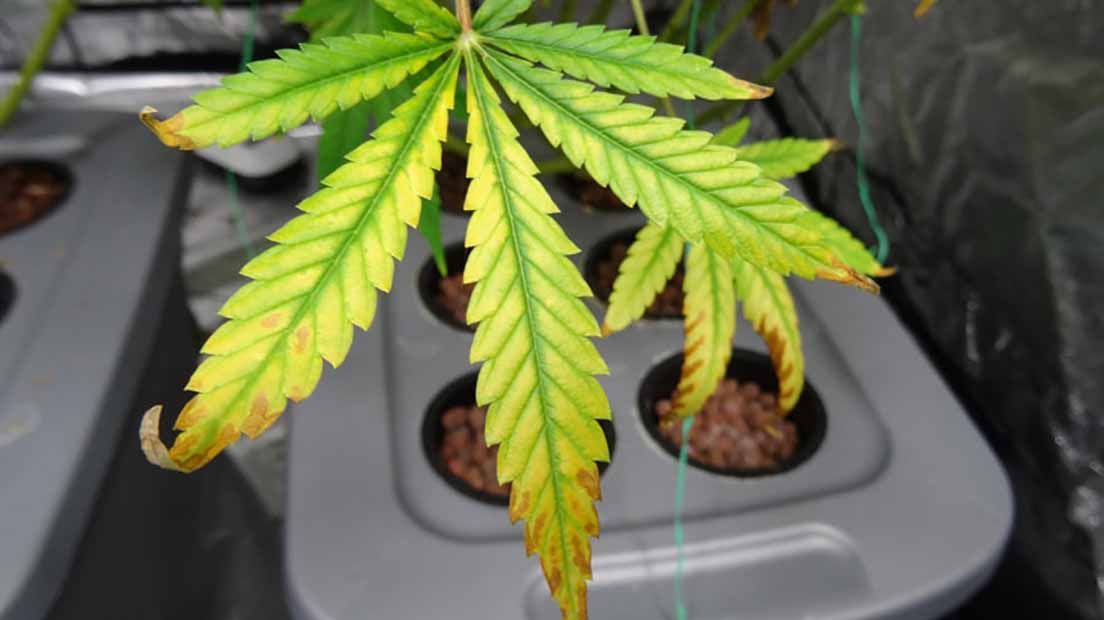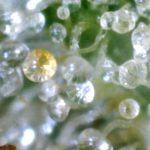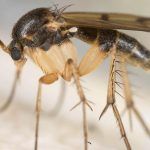Yellow leaves on marijuana, learn what’s causing it
Have you noticed some of your marijuana plant leaves turning yellow? Yellow leaves can develop on marijuana plants for a number of different reasons, so it can be difficult to know what’s causing it. In this article we’ll take a look at how to spot the cause of the yellow leaves in marijuana plants that every grower wants to avoid.
Factors that cause yellow leaves on marijuana
There are many factors that can cause marijuana leaves to turn yellow, from bad pH levels and over watering to nutrient deficiencies. This issue is a clear sign that something is wrong with the crop. In other words, it’s the plant’s way of warning us that something is wrong in its growth process. In order to alleviate this problem, it’s important to identify the primary cause, and to do this the grower should carefully analyze the crop and observe which of the following problems may be occurring. Most cases of yellow leaves on marijuana plants can be cured with little to no effect on the final yield of the crop.
Yellow leaves because of bad Ph
Whether you are growing in soil, coco or hydroponics, the most common cause of yellow leaves is a pH near the roots which is either too high or too low. Marijuana plants have difficulty absorbing nutrients when the pH level is not correct. This results in nutrient deficiencies, even if nutrients are present near the roots.
The clearest symptoms of these incorrect pH levels are yellow and brown spots on the leaves and burned leaf edges. Growers who don’t take care of the pH levels of their crop are often at risk of encountering nutrient deficiencies in their marijuana crop. Optimal pH levels for cannabis are:
- Soil: 6-7 pH points.
- Coco/Hydro: 5.5 6.5 pH points.
To measure the pH levels in the water used to irrigate the crop, a digital pH meter can give you accurate readings in a few seconds. If the levels turn out to be incorrect, you can adjust them using products to lower the pH of hard water, such as Hydro Pro’s pH Down. On the other hand, if you need to raise the pH level, you should instead use products such as pH+ from General Hydroponics.

The picture above/below shows yellow streaks on the leaves. This type of marking indicates that the problem is not caused by a deficiency in nutrients such as nitrogen. In this case, the symptoms were instead caused by a pH level that was too high.
Poor Irrigation
It is much more common to over water than to underwater, although the symptoms of each are very similar, with yellow leaves being the most prominent. In both cases, the solution is to learn to give the plants the right amount of water at the right time.

Overwatering is more common in young plants, as their roots are weaker and we tend to give them more water than necessary. In the same way, poorly oxygenated and poorly drained soil can also be a cause of overwatering. Not paying enough attention to the plants can lead to risky problems for the crop, usually resulting in the loss of leaves and, of course, yellowing leaves. On the other hand, although less common, lack of watering can also lead to the same issue. Poor irrigation can be difficult to detect as it may also be confused with nutrient deficiencies. The main clue here is that the plants will perk up when they are watered correctly.
Some symptoms of poor marijuana irrigation are:
- Drooping plants. Although it’s normal for plants to droop slightly when the lights are switched off, it’s important to ensure that this type of drooping doesn’t occur at the beginning of the light cycle.
- Swollen leaves. This is particularly an issue when growing small plants in a large pot, as this increases the risk of overwatering.
- Pale and thin leaves. A chronic lack of water leads to the plant acquiring yellowish colorations on its leaves.
- An example of over watered plants can be seen in the image below, with yellowing and evidently drooping leaves.
To reduce the risk of over watering your marijuana plants, the crop should be started with a quality substrate and make sure that the plants are in the right size container. If you notice plants starting to lose firmness immediately after watering, you are over watering them. If you instead notice them perking up when you water them, you are under watering them. Learn more about how to correctly water your marijuana plants in this article.
Nitrogen Deficiency
Yellow marijuana can also be characteristic of nitrogen deficiency. The main symptom here is that yellow spots tend to appear on the underside of the plant. These leaves will also have a soft texture and will be easy to pull off, if they don’t simply off by themselves. Therefore, if you see a yellow leaf with a dry texture that is difficult to pull off, you can rule out nitrogen deficiency.
This problem usually occurs when there are depleted nitrogen reserves in the soil. This is something that tends to happen when marijuana has been in the same pot for too long without being properly nourished. You’re therefore unlikely to experience this problem if you have provided the recommended amount of nutrients to the marijuana crop.

The good news is that it is an easy problem to solve. First, it’s needed to provide the plants with a nitrogen rich plant nutrient, such as Canna Mono Nitrogen. Then, transplant the marijuana to another container with fresh, oxygenated soil. You can learn more in this guide to detecting and caring for nitrogen deficient plants.
Light Burn
If the marijuana plants are exposed to excessive light or bring them too close to the grow lights, it is very likely that you will see yellow leaves begin to form. In this case, this yellowing will appear in the higher regions of the plant, where the light hits the plant most. Unlike yellow leaves caused by overwatering, when the leaves are burned, they aren’t easy to pull off and won’t fall off by themselves. They appear late in the growth cycle, usually after the plant has passed the sixth week of flowering.
This problem occurs when the leaves work too hard in too short a time, causing them to die early due to overexposure to light. Even if you regulate the temperature properly, your plants can still suffer from yellow leaves if they’re too close to the light. This type of burn is more common with more powerful lighting systems such as HPS, LED or LEC, but also when there is no protective glass between the bulb and the plants. In the same way, genetics can also be a determining factor, as some plants are more sensitive than others.

To fix burned marijuana leaves, you should simply move the lights further away from the affected plants. If in doubt, always follow the manufacturer’s instructions regarding the optimum distance from the plants. Learn more about correct lighting in this article.
Temperature related Issues
When you notice yellow leaves on marijuana close to the light, it may also be due to a temperature problem. In order to differentiate the symptoms from those of burned leaves, you’ll notice that the leaves begin to bend, forming the shape of a heel. Place your hand on the affected leaves and leave it there for about 30 seconds. If you notice that the heat is unbearable, it is probably also unbearable for your plants.

Although rare indoors, where growers tend to fight the heat rather than the cold, a temperature below 10 degrees can also cause yellow leaves on marijuana. In addition to stunted growth, some plants will die if they reach these temperatures. An example of this temperature would be if your crop sits atop a cold basement floor.
So, how can you fix this? As we mentioned before, if it doesn’t pass the hand test, the plant is getting too hot. In this case, you should move the grow light further away. If the temperature at night is below 15 degrees or 29 degrees, then it may be necessary to change the ventilation of the growing space. Your plants will also be more resistant to cold if you keep their roots warm, which is why you should avoid placing them on excessively cold surfaces.
Keep reading with Positive Testing for Consumable CBD and The Best Sativa Strains of 2020. Pictures vía Growweedeasy















